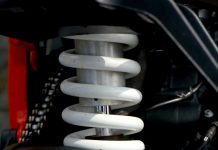The shock absorber is needed to dampen the shocks and jolts that the car body receives through the wheels, while driving. In addition, the shock absorber ensures reliable contact of the car wheels with the road surface. So its purpose is not only comfort, but also safety.
Structurally, shock absorbers can be divided into three main types: two-pipe, two-pipe with gas backing and single-pipe with gas backing. Two-pipe hydraulic shock absorbers were the first to appear on cars. They, as the name suggests, have two tubes – cavities, one of them (internal) has a piston with the above valves, the other (external) is needed to compensate the oil volume – it is filled with oil only partially, the rest is air.
When the shock absorber works, the oil inside heats up to high temperatures, expands, and, in order not to squeeze out the rod seals, the liquid flows into the outer cavity.
Video:
Video about shock absorber replacement from autodoc.co.uk
Shock absorber installation
The way Shock absorbers in the car are installed has not changed how it works since they were introduced in cars. Thus, always their upper part is attached to the car body or frame, and the lower – to the suspension element, whether it is a lever or beam of the continuous axle. From this and replacement of this element in the vast majority of cases did not give difficulties: unscrewed the lower bolt fastening, unscrewed the upper bolt fastening, and all, the shock absorber in the hands.
With shock absorbers of rear suspensions it is still the same, but with front ones it is a bit more complicated. With the advent of front-wheel drive cars, the question arose where to put the shock absorber, which was mainly attached to the lower arm of the front suspension and interfered with the installation of the driveshaft.
Signs of shock absorber failure
The motion of the car becomes jerky, torn.
- Axle, side collapse during acceleration, braking and maneuvering
- Difficulties in controlling, especially on uphill, downhill and rough surfaces
- A knocking noise in the suspension and on the body may occur
At first it is little noticeable, but soon enough, the negative effects begin to intensify. If you ignore them, there is every chance that it will end in an accident. But similar symptoms occur with problems with other components of the suspension, so it is worth knowing how to check the shock absorbers to make sure that the problem is in them.
Damper strut and shock absorber support replacement – what to look for
In order for the replacement of the shock absorber, rear or front, or replacement of the shock absorber struts passed successfully, it is necessary to clearly understand the type and device of this element of the suspension of the car. Today, the most common have hydraulic shock absorbers, the principle of which lies in the reciprocating movement of their piston, which through a special hole pushes the oil filler from one chamber to the next. That is, these devices transform mechanical kinetic energy into thermal energy.
Let’s proceed directly to the very process of replacing the front shock absorbers with their own hands.
- Remove the front wheels. Remember, replacement of shock absorber struts front, as well as rear suspension is carried out exclusively in pairs.
- Dismantle the hoses that supply brake fluid. In the case of any personal skills that allow you to replace shock absorbers without disconnecting hoses from calipers, you can use them, in which case you do not have to pump the brake system.
- Make dismantling from the top of the strut mounts.
- And now remove the lower mounts.
- Remove the spring, using the previously prepared puller. Be careful when doing this work so as not to distort the spring in any way.
- Remove the defective shock absorber, and then install a new one.








































